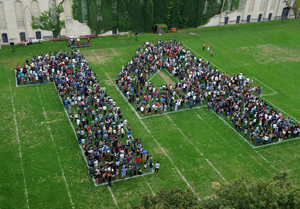Uncommon applicants
An increase in interest made it harder for prospective students to navigate the path to acceptance.
By Asher Klein, ’11
Photography by Dan Dry

Chicago drew a crowd for the Class of ’14; only 19 percent of applicants were admitted.
Despite the Common Application, online paperwork submission, and an entire industry assisting high-schoolers and their parents with the process, in some ways it’s harder than ever to apply to college. “It’s tricky these days,” says S. Arora, assistant director of admissions and director of high-school programs. “These kids face a lot of pressure internally, externally, and they’ll be applying to a lot of schools.”
More than 19,000 students applied to Chicago for the Class of 2014, a 43 percent increase from the previous year. Chicago’s increase in applications was enough to make a fourth-year wonder whether he could make the cut now: When I applied to the College, I was up against 10,000 of my peers; four years before that, around
9,000 applied.
As competition intensifies for spots at elite institutions like the U of C, prospective students try harder to stand out and apply to more schools. The upshot is that the Class of 2014 represents the University’s largest pool of applicants ever. A record low 19 percent were accepted, and 1,388 students enrolled—53 percent male, 62 percent from public high schools, nine percent from outside the United States.
The numbers don’t tell the story for admissions counselors who work to personalize the experience for applicants. “It’s so hard to not have spaces and to offer kids spaces on the wait list,” Arora says. “Just the other day I was talking to a counselor at one of my boys’ schools in Los Angeles, and I was dying to know where this one kid ended up going to college because we couldn’t admit him, but I adored him, my committee adored him—we just didn’t have space.”
The admissions office points to a host of factors that contributed to the spike in applicants. There was the 2008 move to the Common Application, improved U.S. News & World Report rankings (Chicago is now tied for No. 9), and the swell of attention following former Law School lecturer Barack Obama winning the presidency.
Evan Cudworth, AB’09, director of publications at the Admissions Office, also notes that undergraduate life has blossomed in the past 15–20 years, which helped change people’s perceptions of the College. Two new dorms, the Ratner Athletics Center, the coming Logan Arts Center, and other quality-of-life improvements have contributed to a steady increase in applications over the years. “The University just looks like a different place than it did a long time ago,” Cudworth says, “and what we’ve been able to do is get the word out.”
For Cudworth’s office, that means annual e-mails and letters to prospective students with information. Last year’s applicants also received Valentine’s Day love letters written by current students, packaged with a UChicago pennant and scarf.
Another new item, e-mailed a week before applications were due, was a hyperlinked list of the top 17 things to do on campus in the spring, written by two students. No. 5: “Solstice zephyrs? Lame. Antiwinter winds? Not quite there. Summer Breeze? Amazing.”
Some changes at the admissions office could be another cause of the applications spike. It went through a transition in the summer of 2009 with the arrival of Dean of Admissions Jim Nondorf. Rosenwald Hall was rearranged. More officers were hired to handle a larger workload, including travel to more schools and communities around the country.
Tours for prospective students were revamped to include more information about campus life and opportunities for students throughout the city, rather than focusing only on the admissions process and financial aid. Toward that end, more current students were brought in to consult with potential applicants.
The officers, meanwhile, have modified their approach to working with families during the college-application pressure cooker, taking on a larger counseling role. “In our information sessions, it used to be very, ‘If you want to get into the University of Chicago, this is what you have to do,’” Cudworth says. “Now I spend half of the time talking about the Common Application, how to prepare yourself generally for college. I give a lot of tricks of the trade,” such as how to get a teacher recommendation or write a good essay. “It’s not only about UChicago.”
Nondorf initiated that change after an office get-together where staff members compared notes on their presentations. Nondorf’s own style, “sharing anecdotes from his work, encouraging the parents and students to just be calm and to know that they will get into a wonderful college,” became the model for the office, Arora says, adding that they’ve received appreciative e-mails and letters for the warm welcome.
The staff members wish they could welcome more as students. As Arora says, Nondorf “likes to start out his session saying, ‘You’re all so bright and wonderful, and we would want to have about 12,000 of these wonderful kids on our campus.”Return to top
